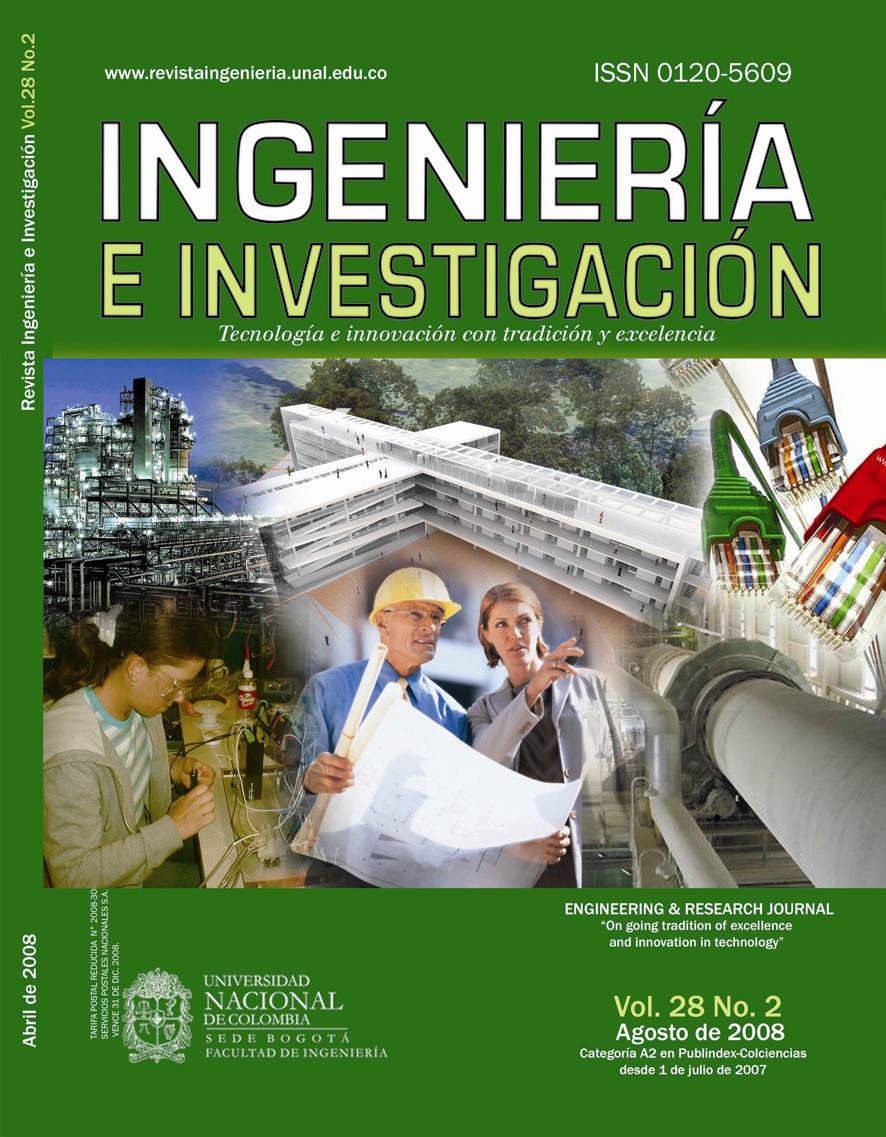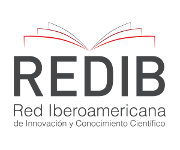X-ray computed tomography and aggregate image system (AIMS) for studying hot mix asphalt and aggregates
Tomografía computarizada con rayos-x y sistema de imágenes de agregados (AIMS) para el estudio de mezclas asfálticas y agregados
DOI:
https://doi.org/10.15446/ing.investig.v28n2.14903Keywords:
materials characterisation, X-ray computed tomography, aggregate imaging system, asphalt mixture, aggre-gate, pavement (en)caracterización de materiales, tomografía computarizada con rayos X, sistema de imágenes de agregados, mezcla asfáltica, agregados, pavimentos (es)
Downloads
Achieving reliable pavement design, durable roadway structures and effective maintenance and rehabilitation plans requires the suitable characterisation of the materials used in pavement construction. This paper describes two nondestructive techniques based on image acquisition and analysis and their successful application in pavement engineering: X-ray computed tomography (X-ray CT) and aggregate imaging system (AIMS). The former has been used for characterising the internal structure of asphalt mixes to analyse and model their performance; it has been particularly used for studying the content, size, distribution and connectivity of air-voids and these variables’ relationship with moisture damage susceptibility, capillarity and permeability within the mixes. AIMS was intended for characterising aggregates’ morphological properties (i.e., form, angularity and texture). This technique provides important advantages regarding the standard methods used for obtaining the same aggregate properties: it is objective, reliable, reproducible and can be carried out quickly. This paper was aimed at describing these two techniques’ theoretical backgrounds, mention some recent applications and provide insight into how existing characterisation of materials used in pavement construction can be improved.
La caracterización de las propiedades de los materiales empleados en ingeniería de pavimentos es fundamental para garantizar diseños confiables, estructuras durables y planes de mantenimiento y rehabilitación efectivos. Este artículo describe dos técnicas no destructivas basadas en la toma y procesamiento de imágenes que han sido exitosamente empleadas para caracterizar materiales de pavimentos: 1) tomografía computarizada con rayos-X, y 2) Sistema de Imágenes de Agregados. La primera técnica permite caracterizar la estructura interna de mezclas asfálticas con el fin de analizar y modelar su desempeño. En particular, esta técnica ha permitido estudiar el contenido, tamaño, distribución y conectividad de los vacíos y la relación de estas variables con la susceptibilidad al deterioro por la presencia de humedad, la capilaridad y la permeabilidad de las mezclas. El Sistema de Imágenes de Agregados fue desarrollado para caracterizar las propiedades morfológicas de los agregados (i.e., forma, angularidad y textura), técnica que proporciona importantes ventajas con respecto a los ensayos estándar ya que las mediciones son objetivas, de rápida ejecución, repetibles y reproducibles. El objetivo de este documento es describir los aspectos teóricos básicos y algunas aplicaciones recientes de estas técnicas que representan nuevas herramientas para mejorar los procesos de caracterización de los materiales empleados en ingeniería de pavimentos.
References
Al-Omari, A., Masad, E., Three Dimensional Simulation of Fluid Flow in X-ray CT Images of Porous Media., International Journal for Numerical and Analytical Methods in Geomechanics, Vol. 28, 2004, pp. 1327– 1360. DOI: https://doi.org/10.1002/nag.389
Al Rousan, T., Characterization of Aggregate Shape Properties Using a Computer Automated System., Disertación Doctoral presentada a Texas A&M University, College Station, Texas, para optar al grado de Doctor of Philosophy, 2004.
Alvarez, A.E., Epps Martin, A., Estakhri, C., Button, J., Kraus, Z., Prapaitrakul, N., Glover, C.J., Evaluation and Recommended Improvements for Mix Design of Permeable Friction Courses., Report FHWA/TX-08/0-5262-3, College Station, Texas, Texas Transportation Institute, Texas A&M University, 2008, pp. 36-39.
Arámbula, E., Masad, E., Epps Martin, A., Moisture Susceptibility of Asphalt Mixtures with Known Field Performance Evaluated with Dynamic Analysis and Crack Growth Model., Transportation Research Record, Vol. 2001, 2007a, pp. 20–28. DOI: https://doi.org/10.3141/2001-03
Arámbula, E., Masad, E., Epps Martin, A., Influence of Air Void Distribution on the Moisture Susceptibility of Asphalt Mixes., Journal of Materials in Civil Engineering, ASCE, Vol. 19, 2007b, pp. 655-664. DOI: https://doi.org/10.1061/(ASCE)0899-1561(2007)19:8(655)
Barrie, P.J., Characterization of Porous Media Using NMR Methods., Annual Reports on NMR Spectroscopy, Vol. 41, 2000, pp. 265-316. DOI: https://doi.org/10.1016/S0066-4103(00)41011-2
Caro, S., Masad, E., Bhasin, A. D., Little, D. N., Moisture Damage Susceptibility, Part I: Mechanisms., International Journal of Pavements Engineering, Vol.9, 2, 2008a, pp. 81-98. DOI: https://doi.org/10.1080/10298430701792128
Caro, S., Masad, E., Bhasin, A. D., Little, D. N., Moisture Damage Susceptibility, Part II: Characterization and Modeling., International Journal of Pavements Engineering, Vol.9, 2, 2008a, pp. 99-114. DOI: https://doi.org/10.1080/10298430701792144
Chen, J., Lin, K., Young, S., Effects of Crack Width and Permeability on Moisture-Induced Damage of Pavements., Journal in Materials in Civil Engineering, ASCE, Vol. 16, No. 3, 2004, pp. 276-282. DOI: https://doi.org/10.1061/(ASCE)0899-1561(2004)16:3(276)
Gatchalian, D., Masad, E., Chowdhury, A., Little, D., Characterization of Aggregate Resistance to Degradation in Stone Matrix Asphalt Mixtures., Transportation Research Record, Vol. 1962, 2006, pp. 55-63. DOI: https://doi.org/10.1177/0361198106196200107
Hanna, A., Aggregate Tests for Portland Cement Concrete Pavements: Review and Recommendations., National Cooperative Highway Research Program. Research Results Digest, Number 281, 2003.
Instituto del Asfalto., Superpave., Superpave Mix Design, Superpave Series No. 2 (SP-2), Lexington, KY, Asphalt Institute, 2001, pp. 35-61.
Kandhal, P., Parker, F., Aggregate Tests Related to Asphalt Concrete Performance in Pavements., NCHRP Program, Report 405, 1998.
Ketcham, R.A., Carlson, W.D., Acquisition, optimization and interpretation of X-ray computed tomographic imagery: applications to the geosciences., Computers & Geosciences, Vol. 27, 2001, pp. 381-400. DOI: https://doi.org/10.1016/S0098-3004(00)00116-3
Kosek, J., Stepanek, F., Marek, M., Modeling of Transport and Transformation Processes in Porous and Multiphase Bodies., Advances in Chemical Engineering, Vol. 30, 2005, pp. 137 203. DOI: https://doi.org/10.1016/S0065-2377(05)30003-2
Kutay, M.E., Aydilek, A.H., Masad, E., Computational and Experimental Evaluation of Hydraulic Conductivity Anisotropy in Hot-Mix Asphalt., International Journal of Pavement Engineering, Vol. 8, No. 1, 2007, pp. 29-43. DOI: https://doi.org/10.1080/10298430600819147
Lekarp, F., Isacsson, U., Dawson, A., State of The Art I: Resilient Response of Unbound Aggregates., Journal of Transportation Engineering, Vol. 126, 2000a, pp 66-75. DOI: https://doi.org/10.1061/(ASCE)0733-947X(2000)126:1(66)
Lekarp, F., Isacsson, U., Dawson, A., State of The Art II: Permanent Strain Response of Unbound Aggregates., Journal of Transportation Engineering, Vol. 126, 2000b, pp.76 83. DOI: https://doi.org/10.1061/(ASCE)0733-947X(2000)126:1(76)
Luce, A., Mahmoud, E., Masad, E., Chowdhury, A., Relationship of Aggregate Microtexture to Asphalt Pavement Skid Resistance., Journal of Testing and Evaluation, Vol. 35, No. 6, 2007, pp. 1-11. DOI: https://doi.org/10.1520/JTE101080
Mahmoud, E., Development of Experimental Methods for the Evaluation of Aggregate Resistance to Polishing, Abrasion, and Breakage., tesis presentada a Texas A&M University, College Station, para optar al grado de Master of Science., 2005.
Masad, E., Olcott, D., White, T., Tashman, L., Correlation of fine aggregate imaging shape indices with asphalt mixture performance., Transportation Research Record, Vol. 1757, 2001, pp. 148–156. DOI: https://doi.org/10.3141/1757-17
Masad, E., Jandhyala, V.K., Dasgupta, N., Somadevan, N., Shashidhar, N., Characterization of Air Void Distribution in Asphalt Mixes Using X-ray Computed Tomography. Journal of Materials in Civil Engineering, ASCE, Vol. 14, No. 2, 2002, pp. 122-129. DOI: https://doi.org/10.1061/(ASCE)0899-1561(2002)14:2(122)
Masad, E., Little, D., Tashman, L., Saadeh, S., Al-Rousan, T., Sukhwani, R., Evaluation of Aggregate Characteristics Affecting HMA Concrete Performance., Report No. ICAR 203-1, College Station, Texas, Texas Transportation Institute, The Texas A&M University System, Dec., 2003.
Masad, E., X-ray computed tomography of aggregates and asphalt mixes., Materials Evaluation, Vol. 62, No.7, 2004, pp. 775-783.
Masad, E., Birgisson, B., Al-Omari, A., Cooley, A., Analytical Derivation of Permeability and Numerical Simulation of Fluid Flow in Hot-Mix Asphalt., Journal of Materials in Civil Engineering, Vol. 16, No. 5, 2004, pp. 487-496. DOI: https://doi.org/10.1061/(ASCE)0899-1561(2004)16:5(487)
Masad, E., Aggregate Imaging System (AIMS): Basics and Applications., Report FHWA/TX-05/5-1707-01-1, College Station, Texas, Texas Transportation Institute, Texas A&M University, 2005, pp. 2-5.
Masad, E., Al-Rousan, T., Button, J., Little, D., Tutumluer, E., Test Methods for Characterizing Aggregate Shape, Texture, and Angularity., NCHRP Project 4-30A, 2005.
Masad, E., Castelblanco, A., Birgisson, B., Effects of Air Void Size Distribution, Pore Pressure, and Bond Energy on Moisture Damage., Journal of Testing and Evaluation, Vol. 34, No. 1, 2006, pp. 1-9. DOI: https://doi.org/10.1520/JTE13112
Masad, E., Analysis of Aggregate Shape Characteristics and its Relationship to Hot Mix Asphalt Performance., Road Materials and Pavement Design, Vol. 8, 2007, pp. 317- 350. DOI: https://doi.org/10.3166/rmpd.8.317-350
Masad, E., Arambula, E., Ketcham, R.A., Abbas, A.R., y Epps Martin, A., Nondestructive Measurement of Moisture Transport in Asphalt Mixtures., Journal of the Association of Asphalt Paving Technologists, Vol. 76, 2007, pp. 919- 952.
Masad, E., Al-Omari, A., Chen H.-C., Computations of Permeability Tensor Coefficients and Anisotropy of Asphalt Concrete Based on Microstructure Simulation of Fluid Flow., Computational Material Science, No. 40, 2007, pp. 449-459. DOI: https://doi.org/10.1016/j.commatsci.2007.01.015
Otani, J., Obara, Y., X-ray CT for Geomaterials: Soils, Concrete, Rocks., Proceedings of the International Workshop on X-Ray CT for Geomaterials: GEOX2003, Kimamoto, Japan, Royal Swets and Zeitlinger: Lisse, 2004. DOI: https://doi.org/10.1201/9781439834299
Papagiannakis, A.T., Masad, E.A., Pavement Design and Materials., John Wiley and Sons, Inc., 2008.
Watson, D.E., Masad, E., Moore, K.A., Williams, K., Cooley, L.A. Jr., Verification of Voids in Coarse Aggregate Testing, Determining Stone-on-Stone Contact of Hot-Mix Asphalt Mixtures., Transportation Research Record, Vol. 1891, 2004, pp. 182–190. DOI: https://doi.org/10.3141/1891-21
White, T.D., Haddock, J.E., Rismantojo, E., Aggregate Tests for Hot-Mix Asphalt Mixtures Used in Pavements., NCHRP Program, Report 557, 2006.
How to Cite
APA
ACM
ACS
ABNT
Chicago
Harvard
IEEE
MLA
Turabian
Vancouver
Download Citation
CrossRef Cited-by
1. Ponan Feng, Hainian Wang, Heyang Ding, Jinkun Xiao, Marwa Hassan. (2020). Effects of surface texture and its mineral composition on interfacial behavior between asphalt binder and coarse aggregate. Construction and Building Materials, 262, p.120869. https://doi.org/10.1016/j.conbuildmat.2020.120869.
2. M.R.M. Aliha, Hassan Ziari, Ehsan Sobhani Fard, Majid Jebalbarezi Sarbijan. (2021). Heterogeneity effect on fracture parameters of a multilayer asphalt pavement structure containing a top‐down crack and subjected to moving traffic loading. Fatigue & Fracture of Engineering Materials & Structures, 44(5), p.1349. https://doi.org/10.1111/ffe.13434.
3. Mohammad Iqbal Khairandish, Avani Chopra, Sandeep Singh, Jasgurpreet Singh Chohan, Raman Kumar. (2022). Effect of Gradation and Morphological Characteristics of Aggregates on Mechanical Properties of Bituminous Concrete and Dense Bituminous Macadam. Iranian Journal of Science and Technology, Transactions of Civil Engineering, 46(1), p.293. https://doi.org/10.1007/s40996-021-00609-8.
Dimensions
PlumX
Article abstract page views
Downloads
License
Copyright (c) 2008 Allex E. Álvarez Lugo, Edith Arámbula Mercado, Silvia Caro Spinel

This work is licensed under a Creative Commons Attribution 4.0 International License.
The authors or holders of the copyright for each article hereby confer exclusive, limited and free authorization on the Universidad Nacional de Colombia's journal Ingeniería e Investigación concerning the aforementioned article which, once it has been evaluated and approved, will be submitted for publication, in line with the following items:
1. The version which has been corrected according to the evaluators' suggestions will be remitted and it will be made clear whether the aforementioned article is an unedited document regarding which the rights to be authorized are held and total responsibility will be assumed by the authors for the content of the work being submitted to Ingeniería e Investigación, the Universidad Nacional de Colombia and third-parties;
2. The authorization conferred on the journal will come into force from the date on which it is included in the respective volume and issue of Ingeniería e Investigación in the Open Journal Systems and on the journal's main page (https://revistas.unal.edu.co/index.php/ingeinv), as well as in different databases and indices in which the publication is indexed;
3. The authors authorize the Universidad Nacional de Colombia's journal Ingeniería e Investigación to publish the document in whatever required format (printed, digital, electronic or whatsoever known or yet to be discovered form) and authorize Ingeniería e Investigación to include the work in any indices and/or search engines deemed necessary for promoting its diffusion;
4. The authors accept that such authorization is given free of charge and they, therefore, waive any right to receive remuneration from the publication, distribution, public communication and any use whatsoever referred to in the terms of this authorization.



























